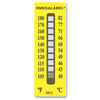Change-of-state temperature sensors consist of labels, pellets, crayons, lacquers, or liquid crystals whose appearance changes once a certain temperature is reached.
They are used, for example, with steam traps; when a trap exceeds a certain temperature, a white dot on a sensor label attached to the trap turns black.
Response time typically takes minutes, so these devices often do not respond to transient temperature changes and accuracy is lower than with other types of sensors.
Furthermore, the change in state is irreversible, except in the case of liquid-crystal displays. Even so, change-of-state sensors can be handy when one needs confirmation that the temperature of a piece of equipment or a material has not exceeded a certain level, for example, for technical or legal reasons during product shipment.
Change-of-state temperature sensors measure just that– a change in the state of a material brought about by a change in temperature, as in a change from ice to water and then to steam.
Commercially available devices of this type are in the form of labels, pellets, crayons, or lacquers.
For example, labels may be used on steam traps. When the trap needs adjustment, it becomes hot; then, the white dot on the label will indicate the temperature rise by turning black. The dot remains black, even if the temperature returns to normal.
Change-of-state labels indicate temperature measurement in °F and °C. With these types of devices, the white dot turns black when exceeding the temperature shown; and it is a non reversible sensor which remains black once it changes color.
Temperature labels are useful when you need confirmation that temperature did not exceed a certain level, perhaps for engineering or legal reasons during shipment.
Because change-of-state devices are nonelectrical like the bimetallic strip, they have an advantage in certain applications. Some forms of this family of sensors (lacquer, crayons) do not change color; the marks made by them simply disappear.
The pellet version becomes visually deformed or melts away completely.
Limitations include a relatively slow response time. Therefore, if you have a temperature spike going up and then down very quickly, there may be no visible response. Accuracy also is not as high as with most of the other devices more commonly used in industry.
However, within the realm of application where you need a non-reversing indication that does not require electrical power, they are very practical.
Other labels which are reversible operate on quite a different principle using a liquid crystal display. The display changes from black color to a tint of brown or blue or green, depending on the temperature achieved.
For example, a typical label is all black when below the temperatures that are sensed. As the temperature measurement rises, a color will appear at, say, the 33°F spot–first as blue, then green, and finally brown as it passes through the designated temperature.
In any particular liquid crystal device, you usually will see two color spots adjacent to each other– the blue one slightly below the temperature indicator, and the brown one slightly above. This lets you estimate the temperature as being, say, between 85° and 90°F.
Although it is not perfectly precise, it does have the advantages of being a small, rugged, nonelectrical indicator that continuously updates temperature measurement.

